From the November 2021 issue of Apollo. Preview and subscribe here.
Start in the basement! That is the only advice I offer to those headed to the National Palace Museum of Korea, which is tucked in the south-west corner of Gyeongbokgung, the largest of Seoul’s Five Grand Palaces, built in 1395. Two floors below ground, not far from artefact-filled galleries, there are twin models of the palace’s surroundings sitting side by side, with countless buildings and trees meticulously rendered. Binoculars are provided to allow visitors to scrutinise their details.
These sprawling cityscapes tell remarkable stories. One shows Gyeongbokgung and the surrounding neighbourhood as they were around 1868, during the reign of the final king of the Joseon dynasty, Gojong. (He held that position from 1864 to 1897 and then declared himself emperor, serving for another decade.) The other depicts exactly the same slice of town after 1910, when Japan completed its annexation of Korea and began to tear down much of the palace, turning it into a park and erecting grand neoclassical buildings.
Intriguingly, the more recent map looks far more alien. After its independence at the end of the Second World War, South Korea went about erasing much of the Japanese construction around the country, and it has undertaken extensive efforts to restore its historical sites. Soaring walls, imposing gates, and intricate pavilions have gone back up. While not all of Gyeongbokgung has been rebuilt in its 19th-century glory (it once had more than 7,000 rooms), a stroll through its tranquil grounds now provides sights straight out of the Joseon era, not least because some young Koreans visit while clad in elegant hanbok – traditional Korean clothing – rented by the hour from nearby shops. (All five of the palaces, or gung, waive their modest admission fees for those in costume.)
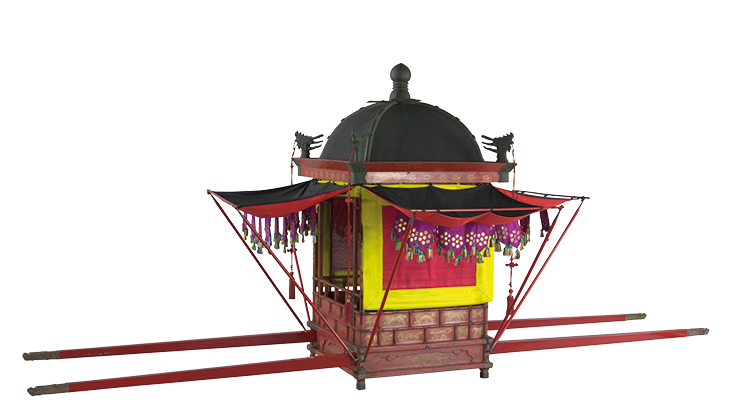
Palanquin of the king, Joseon dynasty (1392–1897). National Palace Museum of Korea, Seoul
The National Palace Museum of Korea is devoted to the study of that vanished world, via more than 40,000 objects from the Joseon dynasty (1392–1897) and the Korean Empire (1897–1910), holdings which range from royal records to official portraits, scientific inventions to ancient weapons, and musical instruments to everyday tools. The dynasty is no more, but as the museum’s director, Kim In Kyu, puts it, ‘Much of today’s Korean culture is connected to the Joseon era’ – a period marked by hardships and accomplishment, guided by a Neo-Confucian ideology that still shapes contemporary society.
The tale of the museum’s creation and evolution provides a superb lens for understanding South Korea’s difficult history over the past century. Like so many cultural institutions in this museum-mad country, the National Palace Museum, in its current incarnation, was created fairly recently, though it traces its roots far back through complicated and turbulent times.
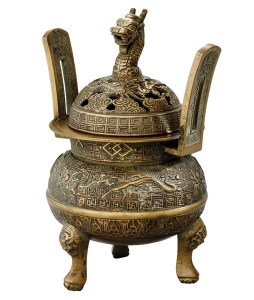
Incense burner, Joseon dynasty (1392–1897). National Palace Museum of Korea, Seoul
It was christened in 2005, when it moved into its Gyeongbokgung home, amid a continuing museum-building boom. (In 2019, the Ministry of Culture, Sports, and Tourism announced a plan to build 186 museums and galleries by 2023, bringing the country’s total number above 1,300.) However, the seed of the museum was actually planted at the very end of the Korean Empire, around 1909, when Emperor Sunjong established an imperial museum in Changgyeonggung (a palace a short walk to the east from Gyeongbokgung) to preserve material from the Joseon dynasty.
When the Japanese consolidated their political domination of the Korean peninsula in 1910, the Imperial Museum became the Yi Royal Household Museum – Yi being the dynasty’s family name. The Japanese split off more than half of the museum’s collection to create an art-focused museum at another nearby palace, Deoksugung. This eventually became the National Museum of Korea, with a purview that spans thousands of years.
In the 1990s, the objects that remained at Changgyeonggung made their way into a Royal Artefact Exhibition Hall at Deoksugung – and that became the Palace Museum in 2005, when it was joined with material from other royal palaces and tombs, and moved into its present location in Gyeongbokgung. Its home, expanded in 2007, is a discreet, low-slung building that matches the airy character of the pavilion-dotted palace grounds.
These administrative moves took place during years of political decay, a foreign occupation, a brutal civil war, the partitioning of the country, and a military dictatorship – daunting conditions for managing precious objects. Important, rare, and alluring objects nevertheless survived, and some of them bear traces of those traumas. Delicate paintings of Joseon court officials, for example, are singed by flames from a fire that broke out during the war in the early 1950s, nearly consuming them.

Nine imperial seals returned to South Korea in 2014. National Palace Museum of Korea, Seoul
High-level diplomacy has brought back into the fold other items scattered by war, such as a number of seals which President Barack Obama returned on a state visit to Seoul in 2014. Among those was the hwangjejibo, a jade seal topped with a fearsome dragon that was used by Emperor Gojong when appointing officials. Taken out of the country by a lieutenant in the US Marines, it is now designated by the government as a treasure, one of many that the Palace Museum safeguards. Such seals ‘are meaningful in that they were taken out of Korea during difficult times, such as the Korean War, but later returned’, Kim says. In 2011, Japan returned more than 1,000 ancient books that it had taken during the colonial period, including more than 100 volumes of Uigwe, which document protocol, rituals, and events in the royal court through writing and illustrations. (Such material has been vital for reconstructing lost architecture and re-enacting ceremonial occasions.)
The institution is smartly laid out to provide an expansive picture of the history of the Joseon dynasty and a vivid sense of its culture. It starts with a chronological introduction to the Joseon monarchs – there were 27 over more than 500 years, in a not-unimpressive show of individual endurance – and it then offers up exhibits devoted to discrete topics such as royal rituals and court life. That said, the collection is so wonderfully multifarious that the less linearly minded should feel free to treat it as a vast and idiosyncratic encyclopaedia of history, politics, and symbols (Figs. 3 & 4).
Visitors struck by the hwangjejibo’s jade dragon can seek out another dragon, serpentine and made from bronze, which was fished out of a pond near a pavilion in Gyeongbokgung, apparently having been placed there in the 1860s in the hope that the mythical creature’s ability to control water might prevent fires at the wooden structure. (Regrettably, fires still broke out.) And a swirling blue dragon is emblazoned on a vibrant red flag that accompanied the king on his travels.
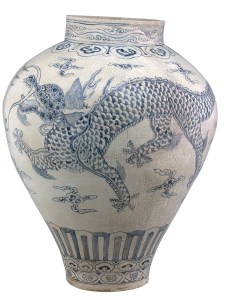
Blue-and-white jar with dragon design (late 18th century). National Palace Museum of Korea, Seoul
Another royal symbol is at the centre of a satisfying exhibition (until 31 October). Composed of the museum’s own holdings as well as loans, ‘Peonies: The Flowers of Peace and Prosperity’ offers up a feast of items bearing that revered plant, including 19th-century inkwork by Heo Ryeon and a cushion cover from 1830 embroidered with a garden. ‘Peony designs were used throughout the process of worshipping the deceased kings and queens as ancestral gods of the royal court to pray for the peace and prosperity of the royal family,’ Kim says, explaining that the show has aimed ‘to bring some comfort to visitors who might be having a difficult time due to the Covid-19 pandemic by offering them an opportunity to indulge in these peonies embodying wishes for peace and prosperity’.
The exhibition features artificial flowers, digital forest imagery, a mirrored hallway in the Yayoi Kusama mould and even floral scents – a fairly surreal atmosphere in all. One highlight is a flower-covered wedding robe made in 1830 for Princess Bokon, who died two years later, at the age of only 13. The museum purchased the majestic red garment, known as a hwarot, in 2020, and after analysis, it ‘is presumed to have been produced by reusing embroidered fabric pieces from other hwarot’, Kim says.
Other temporary exhibitions have allowed the museum to put such conservation work and scholarship front and centre. Late 2020 brought a stunner of a screen painting – more than 25 feet long – from the Dayton Art Institute in Ohio. The gold-leafed painting of longevity symbols (such as peaches and cranes) had been catalogued as Japanese, and then as Chinese, but an eagle-eyed researcher’s questions led to its identification as a major late-Joseon piece that was likely associated with the court. With a grant from the Overseas Korean Cultural Heritage Foundation, which cares for Korean works outside of the country, the Palace Museum undertook extensive restoration work. (It has three labs, measuring more than 4,500 square feet). The painting was transferred from six panels to the 12 it had originally, and patches of the later paintwork were removed. Illuminated in a dark gallery at the Palace Museum after a thorough cleaning, the work was an impressive sight. It has since been sent back to Dayton.
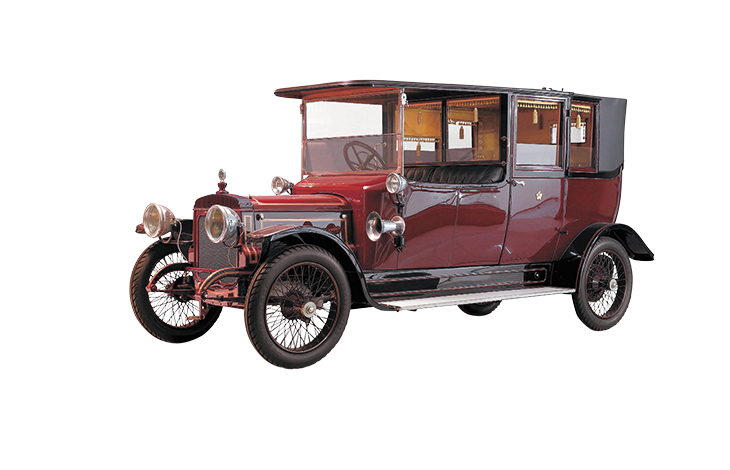
Daimler belonging to Empress Consort Sunjeong (1894–1966), 1914 (?) model. National Palace Museum of Korea, Seoul
The richness of the museum’s eclectic displays also allows visitors to track specific aspects of court life through the ages as they wander – the transport of royal personages, for one. For centuries, they were carried in a palanquin; one on display here is painted a deep red and ornamented in gold with the unicorn-like qilin and other mythical animals (Fig. 1). In a handscroll and a folding screen (reproductions of key 18th-century artefacts held in other collections), palanquins appear in elaborate processions, accompanied by a well-ordered array of colourfully attired soldiers and advisers. A short stroll away, one can see what these sturdy, handheld carriages eventually gave way to: plush automobiles. A black and dark red 1918 Cadillac of lacquered wood ferried Emperor Sunjong (by then powerless under the Japanese annexation), while Empress Sunjeong went with a burgundy British Daimler, its doors and interior lining marked with plum blossoms
An intense level of intimacy is established with the Joseon rulers and their families. Beyond their vehicles, there is tableware, furniture, tools for ancestral rites, and clothing, like a small military outfit – red and blue, with golden tassels – that Imperial Prince Yeong (1897–1970) wore as a young child. There is also the radiant six-panel screen that sat behind the king’s throne, showing the sun, the moon, and five towering mountain peaks (see cover).
The jars that held the tae – the placenta and umbilical cord – of royal babies were once buried at promising sites with the hope of promoting a successful life. A nested pair of smooth white porcelain jars date back to 1661, made for the future King Sukjong, who reigned from 1674 to 1720. Two vessels of unglazed stoneware, somewhat rough-hewn but sturdy-looking, are older still, dating from the late Goryeo dynasty, which gave way to the Joseon in 1392 when Yi Seong-gye (King Taejo) seized power. The tae of his fifth son, King Taejong, Joseon’s third ruler, was once held inside the inner pot.
But one great joy of the Palace Museum is that it does not focus exclusively on the high and mighty. There are artefacts from members of the ‘different social strata who lived in the Joseon royal palaces, from the king to the lowliest servant,’ Kim says. Glimpses of the lives of everyday people appear through less lavish (but often quite handsome) objects, such as branding irons used to imprint a seal on a wijangpae, a tag worn by a guard commander tasked with protecting a royal palace. A sizeable display devoted to the musical legacy of the Joseon dynasty includes a pyeongyeong (a set of 16 L-shaped jade chimes on a painted stand).

Imaginary Painting of Chinese Palaces on Ten-panel Folding Screen (late 19th/early 20th century). National Palace Museum of Korea, Seoul
For those who do not go in for history lessons, or who are somehow left unenchanted by the many hypnotically detailed illustrations of ceremonies and architecture on hand, unexpected aesthetic pleasures still wait. Aficionados of contemporary art may even be startled by some parallels. Earthenware figurines that once adorned the hips of palace roofs, representing characters from the 16th-century classic Journey to the West, have the ramshackle charisma of Jörg Immendorff’s sculpture. A folding screen painted to resemble book-lined shelves, from the turn of the 20th century, has both a dash of John F. Peto’s trompe-l’oeil magic and a flat-planned language that invokes canonical minimalism. A black inkstone larger than a person’s torso, shaped like a giant lotus leaf, inlaid with mother-of-pearl, and set in a wooden lacquer case, might be the envy of any abstract sculptor of the past 100 years.
Even the scientific equipment dazzles. A cylindrical rain gauge stuck into the middle of a stone block may bring to mind certain Donald Judd works or even the Robert Gober sculptures that feature penetrating pipes. The stone, which bears text that includes details about its making, dates to 1782 and is registered as a National Treasure.
Let’s examine one last National Treasure: a tall stone monolith that charts constellations in the sky. Its pinprick stars and celestial markings are still faintly visible more than more than 600 years after its conception, during the kingship of Taejo, in 1395 – the same year in which Gyeongbokgung was built. In later times, printed copies were made from that weathered stone sentinel, and, in 1687, on the orders of King Sukjong, its contents were transcribed to another stone, which is also here. These two stones, separated by nearly three centuries but joined by a common purpose, are emblematic of the National Palace Museum of Korea’s mission to carry its store of knowledge securely into the future.
In December, the Palace Museum will stage an exhibition to mark the 30th anniversary of the excavation and restoration of Gyeongbokgung, charting the work done so far and outlining future plans. Some efforts are already underway: in 2020 the process began of restoring – using traditional construction methods – an area used by the Joseon crown prince, which was destroyed during the Japanese occupation.
This latest work is another chapter in the long history of repair efforts at Gyeongbokgung. Badly damaged during an Japanese invasion in the 1590s, it was rebuilt again only in the 1860s. When restorations were being done in 2001, ceremonial documents were discovered that list some of the officials and workers involved in 19th-century rehabilitation, as well as a poetic dedication composed by a Jo Dusun. ‘Hurray! We threw crossbeams downward,’ it reads near its end, finally concluding, ‘The king does not refrain from listening to his people / Who will be blessed with [this] spacious mansion.’
From the November 2021 issue of Apollo. Preview and subscribe here.
Unlimited access from just $16 every 3 months
Subscribe to get unlimited and exclusive access to the top art stories, interviews and exhibition reviews.

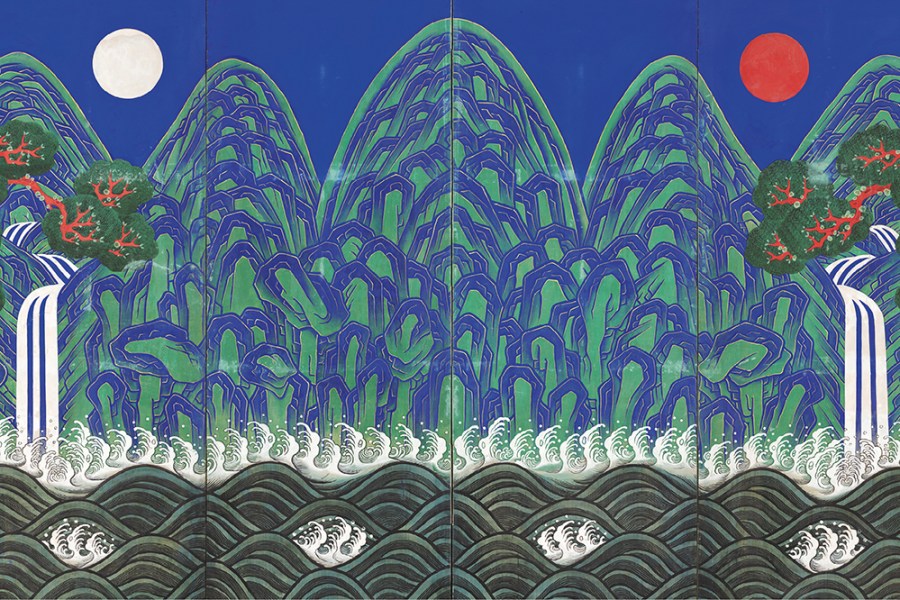
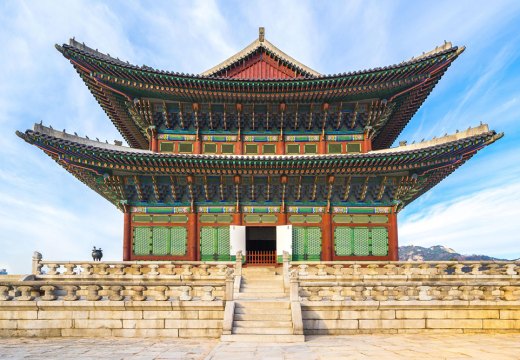
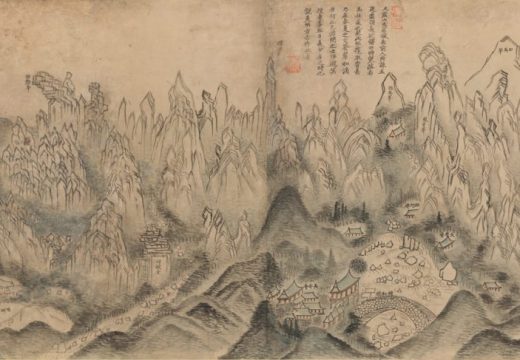
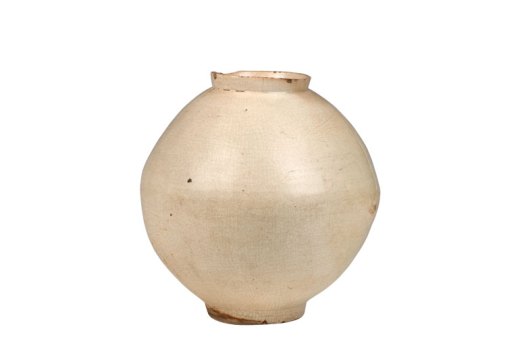









![Masterpiece [Re]discovery 2022. Photo: Ben Fisher Photography, courtesy of Masterpiece London](http://www.apollo-magazine.com/wp-content/uploads/2022/07/MPL2022_4263.jpg)
Why are fathers so absent from art history?